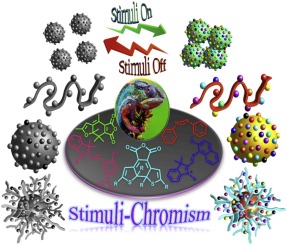Progress in Polymer Science ( IF 27.1 ) Pub Date : 2019-08-19 , DOI: 10.1016/j.progpolymsci.2019.101149 Amin Abdollahi , Hossein Roghani-Mamaqani , Bahareh Razavi

|
Light-responsive polymers, especially photochromic ones, are among the most interesting classes of stimuli-responsive materials. Photochromic polymers can show different stimuli-chromic properties depending on the applied stimuli, chemical structure, and the surrounding media. Such polymers are commonly prepared by incorporation of photochromic compounds in polymer matrices to exhibit stimuli-chromic behavior. Photochromic compounds used in advanced materials include spiropyran, spiroxazine, azobenzene, and diarylethenes, while the recent studies have focused on their response to various stimulants. Stimulants may be classified into three types, physical, chemical, or biochemical, according to their effects on stimuli-chromic materials. Stimuli-chromic polymers that change color on stimulation may responds to light (photochromism), pH (acidochromism and basochromism), temperature (thermochromism), stress (mechanochromism), electrical potential (electrochromism), gelation (gelochromism), solvation (solvatochromism), pressure (piezochromism), water (hydrochromism), and also two or more stimulants (multi-stimuli-chromism). Chemosensors based on stimuli-chromic materials have received considerable attention as they may be used to sense a wide range of chemicals and targets, such as polarity, pH, temperature, positive ions, negative ions, stress, pressure, water, and also biomolecules. Studies focused on stimuli-responsive polymers based on photochromic compounds and different stimuli-chromic phenomena are comprehensively reviewed in the following. Effects of a photochromic compound on its polymeric substrate, matrix or carrier, and the converse effects are carefully investigated to further understanding of different stimuli-chromism phenomena. In addition, the most frequently used synthesis methods to prepare photochromic compounds and their corresponding stimuli-chromic polymers are investigated in detail. Photochromic properties may considerably be influenced by interactions of a photochromic compound with its surrounding media. Incorporation of photochromophores to the polymeric or non-polymeric matrices without decrease of photochromic properties, photofatigue resistant, photoswitchability, and photostability, in addition to removal of negative photochromism are the most significant challenges. This review presents new strategies to overcome these problems and new applications as optical and non-optical chemosensors in the future for a large family of photochromic compounds and its related stimuli-chromic polymers.
中文翻译:

智能聚合物中光开关的激发变色:化学传感器的最新进展和应用
光响应性聚合物,尤其是光致变色聚合物,是最有趣的刺激响应性材料。光致变色聚合物可以显示出不同的刺激变色特性,具体取决于所施加的刺激,化学结构和周围的介质。通常通过在聚合物基质中掺入光致变色化合物以表现出刺激变色行为来制备这种聚合物。先进材料中使用的光致变色化合物包括螺吡喃,螺恶嗪,偶氮苯和二芳烃,而最近的研究集中在它们对各种兴奋剂的反应上。根据刺激物对刺激变色材料的影响,可以将刺激物分为三种类型,物理的,化学的或生化的。刺激变色的刺激变色聚合物可能对光产生响应(光致变色),pH(酸性变色和重铬酸变色),温度(热变色),应力(机械变色),电势(电致变色),胶凝(凝胶变色),溶剂化(溶剂变色),压力(离子变色),水(氢变色),以及两种或多种刺激物(多刺激色差)。基于刺激性变色材料的化学传感器已经引起了广泛的关注,因为它们可用于感测各种化学物质和目标,例如极性,pH,温度,正离子,负离子,应力,压力,水以及生物分子。以下,对以光致变色化合物为基础的刺激响应性聚合物和不同的刺激致变色现象的研究进行了全面综述。光致变色化合物对其聚合物基质,基质或载体的影响,仔细研究了相反的影响,以进一步了解不同的刺激色差现象。此外,详细研究了最常用的制备光致变色化合物及其相应的变色聚合物的合成方法。光致变色性质可能受光致变色化合物与其周围介质相互作用的影响。除了消除负的光致变色作用之外,在不降低光致变色性能,耐光疲劳性,光转换能力和光稳定性的情况下,将光致变色团结合到聚合物或非聚合物基质中是最主要的挑战。



























 京公网安备 11010802027423号
京公网安备 11010802027423号